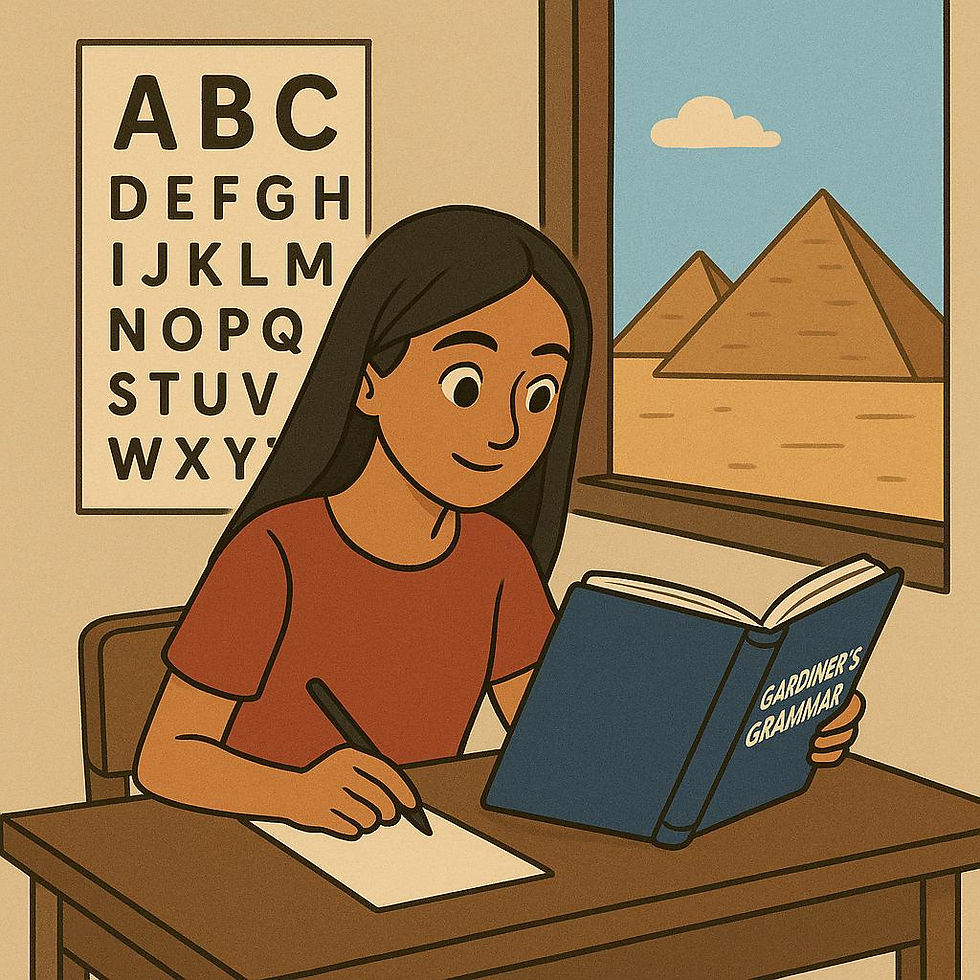Ten-minute hieroglyphs - Lesson 3: Completing the 'alphabet' and alphabetical order
- Dr Sian Thomas

- Jul 5, 2025
- 3 min read
Updated: Aug 1, 2025

Learning objectives
By the end of this lesson:
you will have met the rest of the hieroglyphic 'alphabet', including signs that use non-standard letters in transliteration;
you will have started to become familiar with 'alphabetical order' for hieroglyphs, which is very important if you want to use a dictionary!
You will learn the new signs as follow-up work.
The hieroglyphic 'alphabet' continued: diacritics and non-standard letters in transliteration
Before starting this lesson, make sure that you've memorised the 12 one-letter hieroglyphs from the previous lesson.
You will now meet the rest of the 'alphabet'. Take a look at the flashcards for this lesson. Each card has a hieroglyph on the front and its transliteration and a convenient pronunciation on the back (note the health warnings in previous posts about pronunciation).
The signs that you learned last week are all transliterated using letters from the standard Latin alphabet (e.g. d, p, t), and when we read them out loud we pronounce them in more or less the same way that we pronounce those letters in English. This time you'll see some transliterations that look a bit different:
Some of the new hieroglyphic signs are transliterated using standard letters with added diacritics. Diacritics are extra marks such as dots or dashes written above or below the letter. For example, in addition to the h you learned last time, the new flashcards include signs that are transliterated ḥ, ḫ and ẖ. These represent sounds that existed in Egyptian but can't be conveyed using a single Latin letter. For more details, see the back of the relevant flashcard.
There are two hieroglyphic signs that are transliterated using symbols that do not appear in the Latin alphabet: ꜣ (called 'aleph') and ꜥ (called 'ayin'). See the flashcards for more information.
Please note: As you will have read in my post on transliteration, there are several transliteration systems in use, but the differences between them are not too great. For teaching purposes I've chosen Gardiner's slightly simplified system. If you see transliterations that include z and j (e.g. in Allen's textbook), this just means that they're using a slightly different system, but the vast majority of signs are written the same way in all systems and those that aren't are easy to convert. Ultimately you'll need to be able to use all common systems, and I'll come back to this in a later post.
Alphabetical order
Hieroglyphic dictionaries use an alphabetical order that is NOT the same as English alphabetical order. It'll save you a lot of wasted time flipping through dictionaries if you learn it now!
The order is:

Some hints/ observations:
Aleph and ayin are at/ near the beginning.
Letters that are the same apart from diacritics (e.g. the different kinds of h and s) are grouped together.
In dictionaries, words are arranged in alphabetical order of their transliterations. You'll learn later on that the same word can often be written using more than one combination of hieroglyphs, so when looking up a word first focus on finding the correct transliteration, then check that the hieroglyphic writing in the dictionary more or less matches the one in the text you're reading.
Follow-up
Use the Lesson 3 flashcards and quiz to learn the new signs and practise alphabetical order.
Going forwards, if you own a dictionary or grammar textbook with a vocabulary list in the back, look up each new word you meet and read the entry for it. This is a worthwhile exercise even if you already know what the word means: it helps you get used to using a dictionary from the outset, rather than having to wrestle with it later on.



